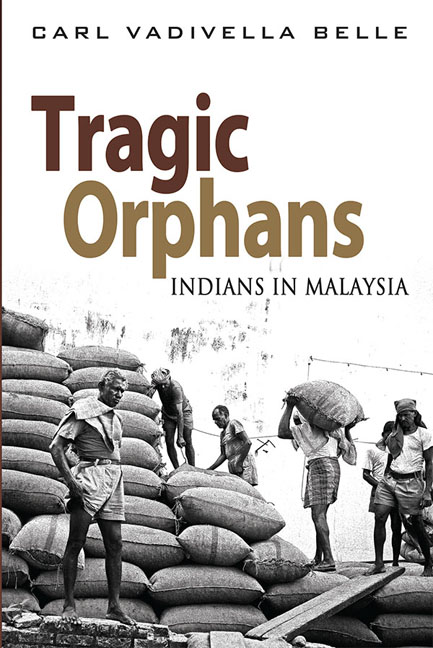Book contents
- Frontmatter
- Contents
- Acknowledgements
- List of Abbreviations
- Introduction
- 1 The Malay Peninsula: Early History, Melaka and the Colonial Setting
- 2 European Colonialism and the Malay Peninsula
- 3 India and the Development of British Ideologies of Empire
- 4 British Governance of Malaya
- 5 Slavery and Indentured Labour
- 6 Indian Indentured Labour in Malaya
- 7 Kangany Labour in Malaya
- 8 Other Indian Immigration
- 9 Indian Political Development to 1941
- 10 The Japanese Invasion, Subhas Chandra Bose and Indian Wartime Nationalism
- 11 The Post–war Period: Reform and Repression: 1945–48
- 12 From Federation to Merdeka
- 13 From Malaya to Malaysia: Singapore, 13 May and the New Economic Policy
- 14 The Mahathir Years: A Changing Malaysian Landscape
- 15 Abdullah Badawi, Islamization, and the Rise of Hindraf
- 16 Najib and 1Malaysia: A New Deal?
- Conclusions
- Bibliography
- Index
8 - Other Indian Immigration
Published online by Cambridge University Press: 06 June 2017
- Frontmatter
- Contents
- Acknowledgements
- List of Abbreviations
- Introduction
- 1 The Malay Peninsula: Early History, Melaka and the Colonial Setting
- 2 European Colonialism and the Malay Peninsula
- 3 India and the Development of British Ideologies of Empire
- 4 British Governance of Malaya
- 5 Slavery and Indentured Labour
- 6 Indian Indentured Labour in Malaya
- 7 Kangany Labour in Malaya
- 8 Other Indian Immigration
- 9 Indian Political Development to 1941
- 10 The Japanese Invasion, Subhas Chandra Bose and Indian Wartime Nationalism
- 11 The Post–war Period: Reform and Repression: 1945–48
- 12 From Federation to Merdeka
- 13 From Malaya to Malaysia: Singapore, 13 May and the New Economic Policy
- 14 The Mahathir Years: A Changing Malaysian Landscape
- 15 Abdullah Badawi, Islamization, and the Rise of Hindraf
- 16 Najib and 1Malaysia: A New Deal?
- Conclusions
- Bibliography
- Index
Summary
British rule in Malaya inaugurated a period of rapid economic and political change. The colonial authorities set about the process of providing the physical structure and administrative apparatus necessary to support a colonial economy and to encourage commercial enterprise. Both government and commercial sectors required the support of a trained English-speaking workforce which possessed a range of specialist skills and expertise. This was not immediately available in Malaya, among either the indigenous Malays or the immigrant labouring communities, and thus had to be imported from abroad. India was a fertile recruiting ground for the required skilled manpower. The expansion of the Malayan economy also attracted other groups — merchants, financiers, and skilled labour — which saw personal and professional advantages in working in colonial Malaya. By 1927 the Agent of the Government of India could report that Indians “other than labourers” resident in Malaya included the following diverse groups: professional and clerical classes of “Madrassi” Tamils and Malayalees; Sikhs and North Indian “Muhammadans” who had, in the main, been recruited to serve in the military and police; Chettiar merchants; South Indian “Muhammadans” who were largely engaged in small to medium business enterprises; and an entrepreneurial/business class from the Bombay Presidency which established an array of medium to large merchant houses. The Agent did not list Ceylonese Tamils who were at that point not officially recognized as Indians by the colonial authorities.
CHITTY MELAKA
We noted in Chapter 1 that Indian Hindu and Muslim merchants had a lengthy history of trade and cultural interaction with Malayan polities and that they comprised established communities within the cosmopolitan Melaka Sultanate. In 1510, on the eve of the Portuguese conquest of Melaka, there were an estimated 1,000 Gujaratis and approximately 3,000 other Indians (mainly Tamils, Bengalis, Parsis, and Malayalees) resident in the city. The Indian communities lived in enclaves known as vira pattanas and collectively comprised a prosperous and respected mercantile class. The Portuguese administrator, Tome Pires, observed that the South Indian Hindu merchants, known as klings, were active as traders and controlled the bulk of commerce conducted between Melaka and South India.
Hindu communities based in Melaka intermarried with local communities, including Malays, Batak, Javanese, as well as Nonya (acculturated) Chinese.
- Type
- Chapter
- Information
- Tragic OrphansIndians in Malaysia, pp. 136 - 148Publisher: ISEAS–Yusof Ishak InstitutePrint publication year: 2014

